
Fore Street & New Bridge Street - then and now
Page added 26 July 2009
Fore Street is arguably the most interesting, eccentric and sleazy street in Exeter. From the top, on a sunny day, there is a tremendous view down the street and across the Exe valley towards the Haldon Hills. Once it was full of grocery stores, butchers and bakeries, along with hat and clothes shops, two cinemas and two churches and a mission hall. Now there is a plethora of fast food outlets, boutiques, a small department store, a fancy dress shop, a tattooist, a used book shop, another selling used CDs and DVDs, two printers and three or four outdoor pursuit shops, and you can also probably buy a cuddly toy! Here, is a selection of photographs, old and new, of the many shops and other buildings that have inhabited the hill of Fore Street and New Bridge Street, through the past hundred years.
Back
to Photo Essays
Also A history of Fore Street

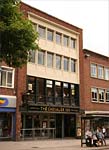 78 Fore Street
78 Fore Street
Chevalier
House, left, had a ceramic horseman on
the roof, supposedly because it was a centre of support for Charles II.
The Chevalier Inn, right, is roughly on the site of the old Chevalier
House. The present building was named the Chevalier when it was built
in the 1950s and has since been Winstons, Churchills and the Hogs Head
before Wetherspoons purchased the premises in 2009 and reverted to the
old name.

 84 Fore Street
84 Fore Street
International
Stores moved to Fore Street sometime in the 1920s. Started as the
International Tea Co., it has, through the years evolved into
Somerfield. Jessop's store now occupies, roughly, the position of the
grocery.
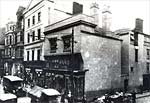
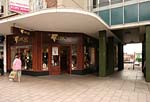 84 Fore Street
84 Fore Street
Milk
Street which leads to the side of the Cornmarket is now just a place to
park. Once, the street led to the rear of the Lower Market where a
public water fountain was placed for the locals to fill their buckets
and jugs. The photo on the left shows the corner of Milk and Fore
Street in the 1920s, when John Helson, ironmonger ran his business from
the corner shop. The Famous, the successor to Pinder and Tuckwell, are in the same,
approximate position.
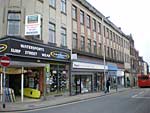
 93-104 Fore Street
93-104 Fore Street
A
night
photograph from the 1960s of the shops running down Fore Street from
the corner of Market Street clearly shows a selection of traders that
no
longer exist. The tailors, John Collier occupy the Harbour Sports
premises with the ladies costumers of Westons in the Service Point
shop. Bata, the shoe shop is the third premises along followed by the
Silver Grill, a popular café run by the Bernie brothers who
started Bernie Inns. Fildews, electrical engineers, Thomas Moore
and Jays Furnishing Stores complete the shops that can be discerned.
Photo left Lydia Barnard.
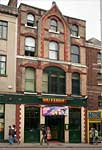
 101 Fore Street
101 Fore Street
The Devon and Exeter Temperance Hotel occupied the
Walkabout bar in 1897. It became the Franklin Temperance Hotel, and, in
1911, the attached assembly room opened as the Franklin Picture Palace. One
wonders what the owners of the Temperance Hotel would make of the use
of the premises now, and as for the live nude dancing at EX4 opposite!

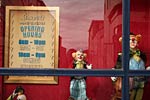 123 and 145 Fore Street
123 and 145 Fore Street
If
one looks carefully,
there can be some odd goods displayed in the windows of shops in Fore
Street. The Stardust Amusement Arcade, at 145 Fore Street, had the
kitsch ceramic clowns in
the window. Lucia Software, at no 123, an electronic games shop had the
pneumatic, in more ways
than one, inflatable Lara Croft figure clutching her torch, on her
archaeological quest for truth, freedom and fit men. If she had visited
the shop in 1897, she would have found Frederick Howe, watchmaker in
residence.

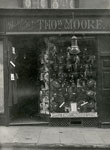 102 Fore Street
102 Fore Street
The
oldest still
surviving business in Fore Street is Thomas
Moore which opened on 21st March 1907. Thomas Moore was
killed in the First World War at the age of 37, and the business was
sold by his mother. The new owners retained the name, which remains
until today. Moore's name can also be found on the roll of honour,
which is on a plaque outside St Olave's Church.
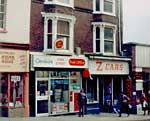
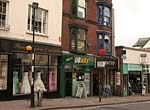 107-108 Fore Street
107-108 Fore Street
The
post office at 107 Fore
Street remained a popular facility until the government insisted on
paying pensions and benefits straight into a bank account – it
closed in the early 2000s and is now a branch of the fast food SubWay
chain. Named after the famous show, Z-Cars ran their taxi service from
the premises now occupied by Gentry, the men's' hairdressers. Photo
right Aubone Braddon.
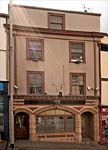
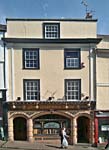 122A Fore Street
122A Fore Street
Originally the Devonport
Inn, a favourite of local squaddies, this bar has, since the
1990s been the Crazy Horse, Moloko, Splash Bar, Velvet Lounge and now
Vivo. One dictionary defines a squaddie as "A member of the armed forces who thinks
he's 'Gods gift to women.'" Which precludes squaddies from Vivo
as it is one of Exeter's gay and lesbian hotspots – and don't ask
the neighbours about the late night noise. The original
Devonport sign, I believe, is still hidden beneath the slick name board.
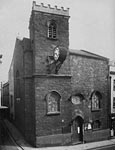
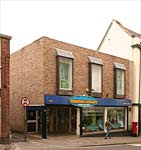 110 Fore Street
110 Fore Street
Once,
Fore Street had
three churches immediately on the street. All Hallows on the Wall was
built across the street, before New Bridge Street was cut. St John's Church, left was
demolished in 1937, although the tower remained until after the war.
The church never had a street number and was next to 110. Now Taunton
Leisure occupy the far from inspiring building now on the site, with
the number 110.
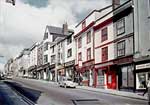
 Fore Street Hill
Fore Street Hill
To the left is a photo of
Fore Street Hill taken in the late 1960s by Alan H Mazonowicz –
the Devonport Inn is the central, red painted, building. Right is a
similar view from slightly further down the street from 1923.
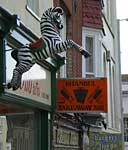
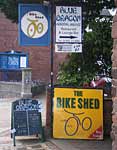 Signs in Fore Street
Signs in Fore Street
During
the 19th Century,
shops would erect small statues, carved decorations and coats of arms
over their shop fronts. Garton and King had a Golden Hammer, and Stones
a phoenix bird. There are still painted signs and occasional, often
illuminated 'objects'. Left a plethora of signs to entice customers
into the Pickwick Arcade, and a zebra over MakeArt at 126 Fore Street,
which in 1917 was 'The Stores' of Oswald Smith, house furnisher.
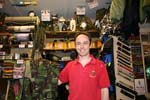
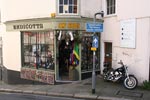 2 West Street
2 West Street
Kevin Endicott runs Endicott's the army surplus store. They have been trading from West Street since
the late 1940s and have established a high reputation for the range of
surplus gear, and keen prices. Although they are just off New Bridge
Street, the shop is still an integral part of business in the area.
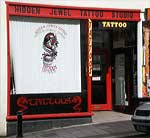
 Tattooing Studio – 2
New Bridge Street
Tattooing Studio – 2
New Bridge Street
Just around the corner
from Endicott's is the Tattooing Studio run by Paul and Lyn. To my
memory, it has been established at least ten years. In 1897 it was Mrs
Cavill's news agent. At 136 Fore Street
is the Hidden Jewel Tattoo Studio, so those into body art have a choice
of venue. In 1917 136 was E C Chalice, tobacconnist and newsagent.
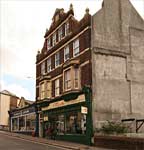
 Otto
Retro – 6 New Bridge Street
Otto
Retro – 6 New Bridge Street
Businesses open and close
in the two streets almost on a daily basis. Otto Retro was, in May
2008, situated at 127 Fore Street – in 1897 the shop contained
Mrs Sarah Stocker, provision dealer. They have since moved down the
hill to 6 New Bridge Street, and when I passed, had an interesting
assortment of old furniture and other bits. No 6 New Bridge Street was
Harry Weston, butcher in 1897.
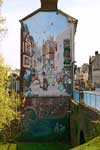
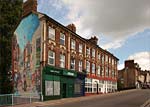 Mural – New Bridge Street
Mural – New Bridge Street
The
first building as you
drive up New Bridge Street houses Joan's the ladies hairdressers. On
the end gable is this fine Westgate
Festival mural by Andrew Stacey painted in 1979. Apart from Joan's,
the rest of the shop fronts are now integrated into living
accommodation – in 1959 the shops contained a branch of Hill,
Palmer and Edwards, a fruiterer, an outfitter and a butcher, as well as
in Joan's, Mrs Northam, the ladies hairdresser.
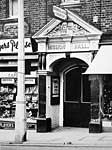
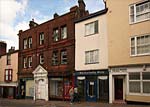 34 and 35 New Bridge Street
34 and 35 New Bridge Street
The
street has several dilapidated and crumbling empty shops that in former
times served a populous local community with all their needs. The Old
Curiosity Shop, right, was an interesting junk shop where you could
find the most surprising things. In the same photograph can be seen the
entrance to the old Exe Island Mission Hall – the photo left from
the 1950s shows Charles Osborne, tobacconnist, left, and Bennet
Brothers boot retailers, right. The door led down a long, sloping
passage that is a bridge from the rear of the premises to the
Assemblies of God church in Exe Island. Some have called it 'coffin way' as it was a route for a
coffin for a funeral. Photo left Express and Echo.
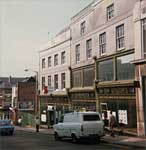
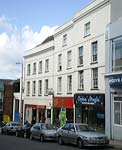 135-139 Fore Street
135-139 Fore Street
Otton's
Ironmongers
supplied the building trade with a wide range of items. They occupied a
large site in Fore Street and their shop frontage spread down the hill
towards Bartholomew Street. Walter Otton occupied 135 Fore Street
from before 1889, the year when they also moved into 110 Fore Street,
when they advertised their "large
selection of coffin funiture in brass, nickel plated and black
trimmings." Photo
right Nigel Bush.
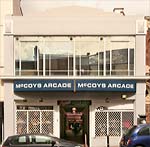
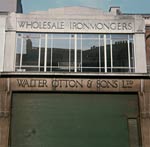 139 Fore Street
139 Fore Street
McCoys
Arcade occupy the
main entrance to the old Otton's empire. In 1897 William Veale and Co.,
grocers, occupied the premises, although, to be sure, without the
façade. Peter Hinchliffe remembers "It was the most fantastic store, (known as
the City's biggest "help yourself to it" store. They sold everything in
hardware from half a dozen screws to Aga cookers, paint, plumbing,
drainage etc. The premises were a labyrinth of small rooms. It was well
known that their shoplifting losses were stupendous." Photo
right, Nigel Bush.
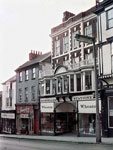
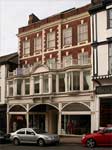 143
Fore Street
143
Fore Street
This town house, dating from 1717, was built by Sir John Duntz, a
cloth merchant who founded the Exeter Bank. It became an office for the
Baring's and in the
1820s, Mr Blackmore an Exeter merchant lived there. Later, the premises
were where Thomas Latimer ran his
campaigning newspaper, the Western Times – Charles Dickens was a
regular visitor to the premises. In the early 20th Century, 143 Fore
Street became a book
shop with a printing works at the rear for Wheatons.
The photo left by Alan H Mazonowicz, shows the building before Wheatons
relocated to Marsh Barton and became Polestar.
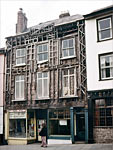
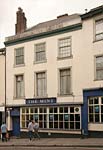 153-154 Fore Street
153-154 Fore Street
The
Mint was "The Medicine
and Chemical Hall"
apothecary in 1838. It became the Star Stores public house around about
1870, which it remained until it was renamed the Mint by 1967. It was
far smaller then, with the
premises sharing a post office for many years. No 153 Fore
Street to the west (both photos) was incorporated into the Mint after
it was refurbished in 1972. From at least 1897, the building was
Knapman and
Co.,
builders, decorators and wallpaper merchants.
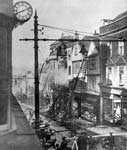
 148-149 Fore Street
148-149 Fore Street
On
17 May 1934, the Exeter City Fire Brigade were called to a major fire
in Fore Street. They used ladders to fight the flames which blazed in
four premises. If you look carefully, you can see that one of the shops
is now the rebuilt premises of the Moorland Rambler, left, which in
1897 was Pyne & Sons, brush manufacturers. The large
clock on the left of the 1934 photo is the 'Moon of Fore Street' that was on St
John's Church.
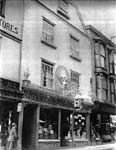
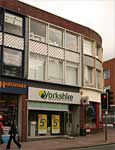 166 Fore Street
166 Fore Street
Stones the Chemist were
most
famous for manufacturing rennet and furniture polish, which is still
made in Devon to a recipe devised in the 18th Century. The shop was
destroyed in the blitz. The Yorkshire Building Society's Exeter branch
occupies the site of the old Stones shop.
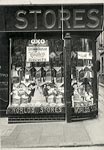
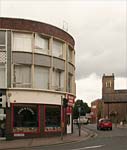 167-168 Fore Street
167-168 Fore Street
The
Golden Horn Fish and
Chip Shop on the corner of Fore and Mary Arches Street occupies one of
the many ubiquitous buildings from the 1950s rebuilding of Exeter after
the war. On the same corner, when Mary Arches Street was much narrower,
there was in 1897, Mrs Loram's grocery store, but in 1917, the
World's Stores opened in the premises, where they remained until the
blitz.
│ Top of Page │